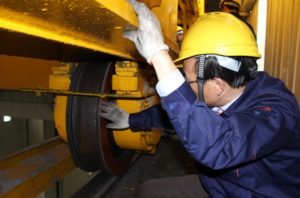The track of the bridge crane is the foundation for the smooth operation of the crane. The track is generally installed together with the load-bearing beam by the steel structure factory installer. In order to let customers know more about the crane track, the editor of our factory introduces the type of bridge crane track and the method of installation and fixing:

Crane rails are usually rolled from steel with higher carbon and manganese content.
The standards used for crane rails include YB/T 5055-1993 crane rails, GB 2585-2007 railway hot-rolled rails, and GB/T 11264-1989 light rails.
The track of the bridge crane should be installed firmly and in line with the track tolerance, so as to avoid the track problem of the bridge crane from gnawing the track .
The editor introduces the installation and fixing methods of the crane rails
In order to ensure the safe operation of the bridge crane, the trolley traveling track of the crane must be fixed on the traveling foundation, and the trolley traveling track is fixed on the main beam. When the crane is working, the track cannot move horizontally and longitudinally, and the track should be easy to adjust.
There are two commonly used track beams for installing tracks: one is a steel structure beam, and the other is a concrete precast beam.
The concrete precast beam must have pre-embedded holes to prepare for the installation of bolts, or pre-embedded bolts in the concrete precast beam.
Crane rail installation methods include pressure plate fixing, hook screw fixing, welding and bolt joint fixing, etc. In order to adjust the horizontal direction, the holes on the track pressing plate are usually made long holes, and the vertical adjustment can be padded under the rail. When designing the track pressure plate, it must have sufficient rigidity. Each pressure plate can be made into a single hole or a double hole according to the magnitude of the force.
The track installation of the bridge crane trolley must meet the following standards:
Contact our crane specialists
Send us a message and we will get back to you as soon as possible.